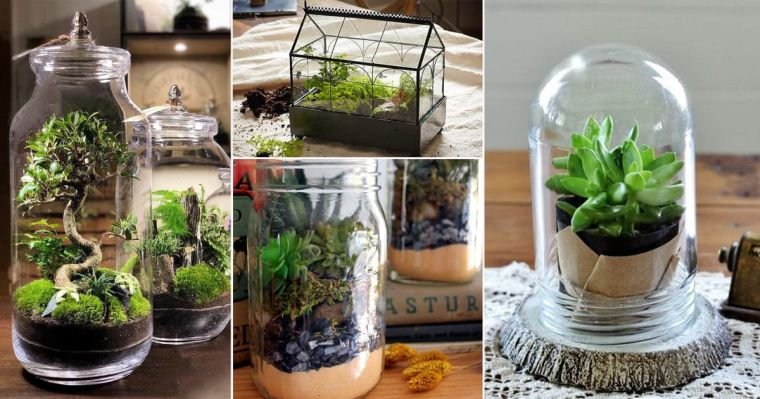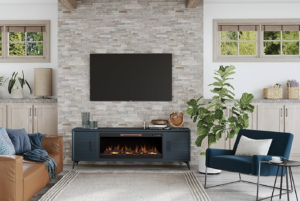
Glass terrariums are perfect to have a little nature inside the home. They are really beautiful and very low maintenance. In the same way, they are excellent additions to the decoration of any home or office. Terrariums are mini gardens in clear glass or crystal containers. One of their biggest advantages is that they are very easy to care for. There are two types of terrariums, sealed and open. Sealed terrariums have a removable lid, while the open terrarium does not. Terrariums can be closed completely to prevent moisture loss. But they are usually left partially open to allow air flow. Glass terrariums give the opportunity to have a mini garden in a small space. In the same way they give life and color to any room and it does not take much to create and maintain them.
Glass terrarium ideas to decorate your home
Of course you will find many places where you can buy a terrarium. But nothing like doing it to your liking. It is actually very easy and fun to do. So we will indicate some tips for you to carry out this beautiful gardening and decoration project for your home. Certainly, you can make a basic terrarium in less than an hour with very few inexpensive materials. Any glass container be it large or small jars, and even goldfish bowls work very well.

As for miniature plants, you can find them in any local store and at very cheap prices. With this project, you will not only be able to have your mini garden and decorate the interior of your home. But they are also wonderful gifts. Well, to create your own glass terrarium you will only need a garden spoon, a glass container with or without a lid. Also gravel, sea glass or beach stones. Some activated charcoal, which you can find at a pet supply store.

Plants for your terrarium, sterile potting mix, leaf moss and if you wish you can also use decorative elements. You can use almost any clear container or glass jar with a mouth or lid to make adding the little plants easier. Consider a large empty pickle jar or a Mason jar. Of course, a wider container will allow you to place more plants, soil and decorative elements much easier.

Choose the plants for your glass terrarium
It should be noted that open terrariums are less likely to experience condensation problems and fungal plant diseases than closed terrariums. Well, for your terrarium you should choose plants that are small enough to fit in your jar. There are many plants that are excellent for glass terrariums, including of course the small potted versions. While open terrariums allow great air flow and are therefore better suited to dry plants like succulents.

As for the closed terrariums, they will be much more humid, so ferns and moss would be better. If you want to choose more than one plant for a terrarium, you should keep in mind that they will share the same habitat. So your choice should require similar levels of light and humidity. If a lot of bright light enters your home, then you can opt for an open glass terrarium with succulents with any of its varieties such as jade, Echeveria succulent, Sempervivum, Haworthia or pearl plant, Kalanchoe Tomentosa or panda plant and Kalanchoe Blossfeldiana.

For spaces with medium light, you can opt for both an open and a closed terrarium. As for the plants for an open terrarium in a space with medium light you can choose between Peperomia, Fern, Pilea, Hypoestes, Selaginella or Snake Tree. For closed terrariums with medium light you can choose between Fittonia, Oxalis triangularis, Neanthe Bella Palms, Asparagus fern, Baby tears. Now, for spaces with very little light, it is preferable that the terrariums are closed. And the best choice is the moss varieties, among them are leaf moss, pillow moss and mood moss.

Create your own glass terrarium
In addition to choosing the type of container and the plants you want in your small garden, it is important that you follow some simple steps to do it properly. Remember that your container will not have drainage holes at the bottom. So you will need to create a drainage layer to help keep water away from the roots of the plants. You can place a layer of moss at the bottom of your terrarium to absorb the extra water.

But in the same way you can start by placing a layer of stones of more or less five centimeters or depending on the size of your container. A tall, narrow terrarium will need a deeper layer of drainage stones compared to a wide, shallow container. Once the stones or pebbles are in place, use a large spoon or a trowel to add a layer of activated charcoal about an inch to a half inch on top of the stones. This will also help drain and control odors.

Then add a layer of moss over the stones and charcoal. This is to prevent the next layer, the potting soil, from mixing with the charcoal and stones. Plus it also adds visual interest to the terrarium. Now with the help of a small spoon or trowel, add the sterile general purpose potting mix to the moss. Add as much potting mix as you can, or at least two inches. But be sure to keep the soil level low enough so that the plants can fit without touching the top of the terrarium.

Design Your Glass Terrarium
Remove the plants from their nursery pots. If they are attached to the root, separate the roots, or even cut them off. Cutting off some roots will slow plant growth, which is good when growing plants in terrariums. But before planting, think and decide the design of your terrarium. Choose where you will place tall and short plants and where you can create mounds and holes in the ground to create interesting outlines. Once you know how and where to place your plants, shake off the excess soil that remains on the plants.

Then, with a large spoon or your fingers, poke a hole for each plant in the potting mix. Now place each plant in its hole and tap the soil around it. If your terrarium container has a narrow opening, use chopsticks, tongs, or long tongs to position the plants and pat them to remove air pockets between the roots and the soil. If you wish, you can decorate the interior of the terrarium with small figures, shells or other elements spaced between the plants.

Now you will need to water the plants in the terrarium with a spray bottle so that they are moist, but not soggy. We recommend using the spray bottle to clean up any dirt on the glass sides of your container. And then you can clean with newspaper. However, it is important that you never use glass cleaner inside a planted terrarium. Since this product could poison plants.

How to Maintain Glass Terrariums
Maintaining a terrarium is actually very easy. You only need to follow three easy steps every two weeks. It is recommended that you feel the ground to see if it is dry and needs water. Glass terrariums that are partially and fully enclosed retain water much longer than most indoor potted plants. Check a closed terrarium for condensation. So remove the top at least once a month to air it out. Leave the top uncovered until the condensation clears. And if you spend a lot of water in the shower you can also leave it uncovered. It is also important that you remove any yellowed or damaged leaves and prune the plants if they are growing large.

Avoid fertilizing the plants in your terrarium
Do not fertilize the plants in your terrarium. Since that can make them grow a lot for the small space of your mini garden. Larger glass terrariums can have indoor plants that are somewhat larger than miniature plants. But avoid fast-growing plants or those that develop large leaves that can block light from smaller plants. It is important that you choose plants that thrive in low to medium light.

Also, try to create a combination of sizes, leaf textures, and leaf colors. Select plants that don’t mind the naturally humid environment of a terrarium. Most people love glass terrariums with cacti, succulents, and moss. But you should avoid being small plants in closed glass terrariums. Those plants work best for fully open containers filled with potting mix that contain a lot of coarse sand.

Common mistakes made with a terrarium
Terrariums are mini gardens that allow you to design and create small ecosystems of small plants and other decorative elements inside a glass container. They can last for several years with proper care. However, many times some mistakes are made. Which should be avoided for glass terrariums to thrive for long.

Too much or too little light
Most plants that are suitable for terrariums do not require extremely bright light. So if placed in direct sunlight or extremely bright light, the terrarium glass can act like a magnifying glass and burn the plants. Keep in mind that the temperatures inside the terrarium can increase very quickly. So it can get as steamy as a sauna. However, most plants cannot tolerate this type of heat.
So you better keep the terrariums out of direct sun. While lots of light can cause problems in your terrarium, most plants need at least some light to survive. If your terrarium is not getting enough indirect light, then you can use grow lights or fluorescent lights to provide additional light. You can also place the terrarium closer to a window that receives good, but indirect light.

Grown plants
You shouldn’t let the plants in your terrarium get too long and grow too long. To keep the plants in your terrarium neat and tidy, cut them back when they have grown large. Remember that you can also prune its roots to keep plants m to small s or that take m to s to grow. Now if a plant in your terrarium appears to be sick, is dying, or is not thriving, then remove it immediately as it can make other plants sick. With the help of a small shovel, toothpicks or a long spoon and remove the plant. Make sure to be very careful not to disturb the roots of other plants. You can replace the plant with one of similar size and the same humidity and light requirements.

Choosing the wrong plants and too much watering
While it is possible to grow almost any species in a terrarium, it is important to choose plants that will thrive in the type of terrarium you are creating. If you are making a closed terrarium, then choose plants that prefer a humid environment. Also, you should make sure to combine plants with the same light and humidity requirements. It is very easy to go overboard and overdo the risk in terrariums. One way to avoid overwatering is to use a spray bottle instead of a watering can. If you overwater, you can soak up the excess water with a paper towel and leave the top of the terrarium open until it dries.





